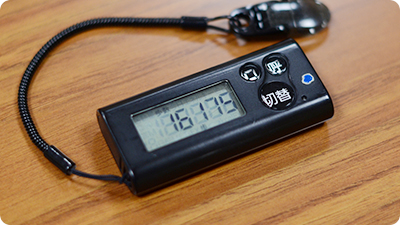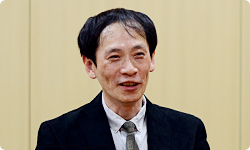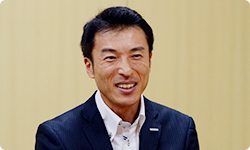When Sugiyama-san and the others went on their field trip to see your technology, Panasonic already had activity meter products, didn’t it?
Yes. I brought a first-generation one today.
(showing an activity meter) This is it. We developed this when screening for metabolic syndrome10 became mandatory in Japan.10. Screening for metabolic syndrome: Metabolic syndrome describes the condition that results from the overlap of lifestyle-related diseases, from visceral-fat obesity to high blood pressure, hyperlipidemia and high blood sugar. In Japan in 2008, a revision to the Health Insurance Act stipulated screening and health guidance for this syndrome for health insurance subscribers over 40 years old.

How long have you been researching activity meters?
Since about five or six years ago. I think the fact that words like “diet” and “metabolic syndrome” were becoming increasingly popular in Japan back then was one reason.
Could you briefly explain to our readers what the difference is between a pedometer and an activity meter?
Of course. A pedometer uses an accelerometer11 to detect swaying of the body to measure things like approximate number of steps taken and one day’s amount of activity. On the other hand, an activity meter has the same accelerometer, but aside from walking, it measures all kinds of daily activities like housework and movements around the workplace to measure the calories burned.11. Accelerometer: A circuit element for detecting changes in speed.

If you use an activity meter, it’s possible to measure each day’s activities in greater detail.
Yes. For example, when using a pedometer, even if your walking speed changes, you get the same number of calories burned for the same number of steps. But instead of the number of steps, an activity meter measures exercise intensity in units called METs, so it can better calculate how many calories you burn in one day.
An activity meter can measure differences in calories burned through chores and work that don’t involve walking and can’t be fully measured by a pedometer. You wear them in different places depending on the type of activity meter, like your hip or arm.
To measure calories precisely, it’s best to have the accelerometer track movement someplace close to the trunk, or central axis of the body. For example, if you put it on your ankle, it’s far from your centre of gravity, so it can’t measure very well.
It’s good to place it near the centre of your body. You clip the Fit Meter to your hip. Does the way it measure change if you stick it in your pocket?
It wouldn’t change much for walking, but if only your pocket moved when moving your body, the accelerometer would react to that, resulting in error. It would, however, mostly be fine in a pocket pressed close to your body.
So the fact of the matter is that the accelerometer inside continuously detects movement, and it estimates the amount of activity from the amount of movement, and calculates calories burned. Is that correct?
That’s right.
I imagine it took a long time to make this. What was the hardest part of development?
Well, first we worked on the programming, but testing that was very difficult.
We compared estimates for calories burned as calculated by the prototype we made, against calories burned measured by another method. We then made adjustments to close any gaps between the two methods to get the logic we had devised to work, but the experiments themselves were quite challenging.

What kind of experiments?
We did things like asking testers to wear a special mask to measure their breaths in order to determine how much carbon dioxide is exhaled in a short period of time, and asking them to run on treadmills for a long time. We gathered lots of people and conducted repeated experiments.
I suppose you would get different results depending on the age and gender of those who are participating, so you must have had to gather all sorts of people.
That’s correct.
I just remembered how people in the company said the development room smelled rather sweaty when the team was working on Wii Fit. You were moving your bodies for measurements every day, so I thought development must have made you stay active.
(looking at each other)
Nothing to say? (laughs)
Um, the developers carrying out the experiments are ageing too, so…
(laughs)
To achieve more accurate data, you have to exercise with a certain intensity for a certain amount of time. But the problem was that the developers would get too tired and give up partway through, so we weren’t able to get data for intense workouts. It was a lot of work! (laughs)
I see! It takes continuous exercise of a certain intensity for a certain amount of time to get useful data, so you said, “You’re flagging, so start over!”
Yeah! (laughs)
© 2024 Nintendo.